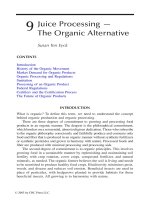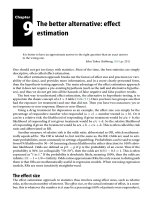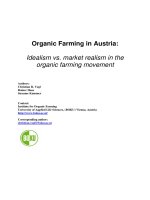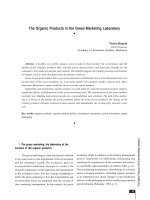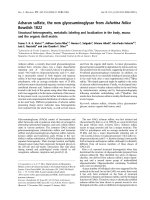Juice Processing - The Organic Alternative
Bạn đang xem bản rút gọn của tài liệu. Xem và tải ngay bản đầy đủ của tài liệu tại đây (3.79 MB, 11 trang )
9
Juice Processing —
The Organic Alternative
Susan Ten Eyck
CONTENTS
Introduction
History of the Organic Movement
Market Demand for Organic Products
Organic Processing and Regulations
Sanitation
Processing of an Organic Product
Federal Regulations
CertiÞers and the CertiÞcation Process
The Future of Organic Products
INTRODUCTION
What is organic? To deÞne this term, we need to understand the concept
behind organic production and organic processing.
There are three degrees of commitment to growing and processing food
products in an organic manner. The deepest is the philosophical commitment,
which borders on a reverential, almost religious dedication. Those who subscribe
to the organic philosophy consciously and faithfully produce and consume only
food and Þber that is produced in an organic manner without synthetic fertilizers
or synthetic pesticides and grown in harmony with nature. Processed foods and
Þber are produced with minimal processing and processing aids.
The second degree of commitment is to organic principles. This involves
growing food in a sustainable manner by replenishing and maintaining soil
fertility with crop rotation, cover crops, composted fertilizer, and natural
minerals, as needed. The organic farmer believes the soil is living and needs
to be nourished to produce healthy food crops. Biodiversity minimizes pests,
weeds, and disease and reduces soil erosion. BeneÞcial insects are used in
place of pesticides, with hedgerows planted to provide habitats for these
beneÞcial insects. All growing is to harmonize with nature.
TX110_book Page 193 Tuesday, May 6, 2003 9:21 AM
© 2003 by CRC Press LLC
The third degree of commitment is to the practices of growing and pro-
cessing in an organic manner. These practices are being conducted and rec-
ognized around the world, some out of choice and some due to necessity.
Organic growing practices within the United States are on land free from
prohibited substances for three years prior to growing an organic crop. No
sewer sludge is applied to the land, and the use of synthetic fertilizers and
pesticides is not permitted. Cessation of chemical application to the land does
not constitute organic practices. This is sometimes called “organic by neglect.”
HISTORY OF THE ORGANIC MOVEMENT
The organic movement, as we know it today, began with Sir Albert Howard,
who combined scientiÞc training with the study of the traditional composting
methods of India and China. In 1940, he advocated that Britain preserve
what he called the cycle of life by adopting sustainable agriculture using
urban food waste and sewage. His published articles were reprinted in the
United States and were a great inßuence on Jerome Rodale. It was Rodale
who coined the term “organic.” In 1942, Rodale published
Organic Garden-
ing and Farming
, which greatly inßuenced the American small farmer. Then
in 1946, Lady Eve Balfour established the Soil Association in Britain. The
main purpose of this organization was to unite those people working toward
a more complete understanding of the vital relationship among plant, animal,
and man. From 1950 through 1962, scientiÞc farming with an emphasis on
chemical fertilizers and chemical pesticides was becoming the hallmark of
agriculture. During this time, a small contingent of farmers shunned the use
of chemicals in agriculture and followed the guidelines established by
Rodale. In the United States, these farmers were considered members of the
counterculture, nonconformists, and even hippies. They were growing crops
in this manner solely out of personal commitment to the land.
The wake-up call about the heavy dependency on chemicals in agriculture
occurred in 1962, with the publication of Rachel Carson’s
Silent Spring
. This
book described the destruction of wildlife and threat to human health from
widespread use of chemicals in commercial farming.
Silent Spring
drew
attention to the harm to avian life resulting from the use of pesticides,
especially DDT. As a result of this book, the use of DDT was banned in
many countries. This is the background that gave birth to organic food
production as we know it today.
MARKET DEMAND FOR ORGANIC PRODUCTS
There is a growing market demand for organically grown and produced food
products. This market demand is driven by the desire to maintain or improve
TX110_book Page 194 Tuesday, May 6, 2003 9:21 AM
© 2003 by CRC Press LLC
health, and people believe that organic growing practices are more environ-
mentally friendly. Typical organic consumers are educated females in their
mid-thirties to mid-forties with children at home. The organic market has
been growing and continues to grow at the rate of 20 percent a year. Con-
sumers have perceived a value added beneÞt to purchasing organic foods.
With increased consumer demand, the cost of organic production has
decreased due to economies of scale. As consumer demand increased, the
major retail markets have added the organic category to their everyday variety
of food. Organic foods are no longer relegated to small natural food or health
food stores. Currently, organic food holds 2% of the food market share. The
industry predicts that organic food will have 5% of the food market share
by 2006. Thus, rapid growth is expected in the next few years.
Many of major food companies are already processing organic foods
such as General Mills with cereals and ßour. General Mills has also recently
acquired the Small Planet Foods Co. Kellogg’s, Dole, and other national
grower/shippers such as Duda and Driscoll have also entered the organic
market. Why have these national food processors entered the organic food
processing business? They see the market demand and potential for market
growth in organic foods. Dramatic market changes will occur in the next
couple of years.
What does it take to enter the organic food processing market? It takes
desire. The organic industry is now a regulated industry; it is regulated by
the United States Department of Agriculture (USDA) and further monitored
by the Food and Drug Administration (FDA) and the Environmental Pro-
tection Agency (EPA). As such, every company in every state will follow
the same regulations. And any food or product labeled “organic” will need
to comply with the USDA organic regulations. If you are ready to produce
an organic beverage, the Þrst step should be to contact a major organic
certiÞer. CertiÞers are accredited by the USDA to certify organic products.
USDA announced the Þrst round of organic certiÞers in 2002.
ORGANIC PROCESSING AND REGULATIONS
As an introduction, let us start with a brief overview of organic processing.
Organic processed foods are safe. Organic processing must comply with all
FDA regulations and all state and local health regulations. While organic
products are grown without pesticides and herbicides, the organic industry
does not claim that products are totally free from pesticides and herbicides.
These synthetic chemicals are in the atmosphere because of drift from non-
organic applications. Within processing facilities, during organic production,
exposure to pesticides is prevented. Organic processing is philosophically
minimum processing with minimal nonorganic ingredients. Some synthetic
TX110_book Page 195 Tuesday, May 6, 2003 9:21 AM
© 2003 by CRC Press LLC
ingredients and processing aids are permitted when there is no organic
alternative. For food safety, citric acid is permitted as a pH regulator; for
functional requirements, baking powder is permitted. Organic food products
are not marketed as healthier than nonorganic versions because insufÞcient
scientiÞc data are available to validate this claim. Yet some consumers
perceive organic products to be healthier. Some organic consumers, because
of serious food allergies, Þnd organic products more agreeable in their diets.
The rules and regulations that control organic growing and processing
are published in the Federal Register, Part IV, Department of Agriculture,
Agricultural Marketing Service, 7 CFR Part 205 National Organic Program;
Final Rule. Under this federal regulation, any producer growing products to
be labeled organic and any handling operation processing food that will be
labeled as organic must be certiÞed by a USDA-accredited certiÞer. Organic
growers, now called the producers, must be certiÞed to verify that the pro-
duction system in place is designed to optimize soil biological activity,
maintain long-term soil fertility, minimize soil erosion, and maintain and
enhance genetic and biological diversity in production. Handling operations
that further process the organic agricultural products must be certiÞed to
verify that they implement organic good manufacturing and handling prac-
tices in order to maintain organic integrity of the products. An intermediary
operation between the producer and the handling operation that takes pos-
session of the organic product, such as a cold storage operation, must also
be certiÞed. Truckers and distributors of further processed packaged organic
foods do not require certiÞcation. Likewise, retail operations do not need to
be certiÞed unless they are further processing organic products. The purpose
of the certiÞcation process of the handling operations is to ensure that the
practices minimize environmental degradation and minimize the consump-
tion of nonrenewable resources. They further verify there is no commingling
with nonorganic ingredients either prior to processing or during the process-
ing operation and that the product and packaging material do not come in
contact with prohibited materials.
What is the composition of an organic juice or beverage? The main
ingredients must be organically grown agricultural products — fruit or veg-
etables. When the beverage is labeled as “100% Organic” juice [7 CFR
205.301(a)], the entire product must be organic with no synthetic ingredients.
Not even the synthetic ingredients approved for use in 7 CFR 205.605 and
205.606 are permitted in this category of organic products. Processing aids
must also be 100% organic; for example, organic rice hulls as a Þlter aid
and organic lemon juice in place of citric acid for pH adjustment. Products
labeled “Organic” [7 CFR 205.301(b)] must consist of a minimum of 95%
organic agricultural ingredients (excluding water and salt), and the remaining
ingredients must be nonagricultural substances, non-organically produced
TX110_book Page 196 Tuesday, May 6, 2003 9:21 AM
© 2003 by CRC Press LLC
agricultural products on the National List of Allowed and Prohibited Sub-
stances (7 CSR 205.605 and 205.606), or ingredients that are commercially
unavailable in organic form. Individual USDA-accredited certiÞers will
determine the “commercial availability” of the speciÞc ingredient based on
documentation supplied by the handling operation. Neither of these label
categories, 100% Organic or Organic, may contain any ingredients that were
grown with sewer sludge or handled with ionizing radiation as described in
FDA 21 CFR 179.26 or contain any ingredient or processing aid that was
genetically modiÞed. A product may be labeled “Made with (
ingredient
category
)” when 70 to 95% of the beverage is produced from an organically
grown fruit or vegetable. In this category, only the organic ingredients must
comply with the restrictions mentioned above. There are no restrictions on
the remaining ingredients. Wine will be labeled “Made with Organic Grapes.”
Sulfur dioxide, on the National List of Approved and Prohibited Substances,
is annotated for use in wine labeled Made with Organic Grapes, at a total
concentration no more than 100 ppm. Any product that contains less than
70% organically grown ingredients may not be labeled organic. Reference
to the organic ingredient may be made on the ingredient panel only.
A vitamin-fortiÞed or nutraceutical organic beverage or juice is not
possible under the National Organic Program. Nutritional vitamins and min-
erals must be in accordance with 21 CFR 104.20. There are provisions in
the federal regulation to petition for additional ingredients and processing
aids to be included. The petitioner needs to document the need for the
inclusion. Recommendations will be made to the National Organic Standards
Board, which will request inclusion in the Federal Regulation.
SANITATION
Sanitation is a critical area in the processing of organic products, especially
if the processing facility handles both nonorganic and organic products.
All normal sanitation procedures must be in place; in addition, thorough
cleaning of all processing equipment must take place prior to the running of
organic product to prevent commingling with nonorganic product. Care must
be taken to eliminate all sanitizer residues on equipment that will come in
contact with organic product. A thorough detergent wash followed by a
thorough rinse is required. Frequent testing is required to verify the total
elimination of sanitizer, and an extra rinse will be used. Sanitizers permitted
in preparation for organic processing are restricted to chlorine materials,
hydrogen peroxide, peracetic acid, phosphoric acid, and sodium hydroxide.
Detailed procedures used in equipment cleaning and sanitizing must be
provided to the certiÞer in the Organic Handling Plan. In a facility that
processes both organic and nonorganic products, it is necessary to maintain
TX110_book Page 197 Tuesday, May 6, 2003 9:21 AM
© 2003 by CRC Press LLC
